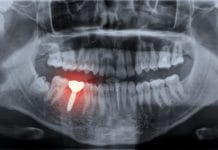They come in waves: the chronic latecomers, the anti-fluoride activists, and the just-plain-strange ones. I’m talking about patients, of course. There is another group that, if you’re not careful, you may miss altogether. And folks, this is a group you don’t want to miss. Let’s call them “the ones with the sneaky tartar.”
As hygienists, what is the one thing we pay most attention to for signs of inflammation or periodontitis? Not sure about you, but I go straight for the gingiva. I’ll assess the color, whether it’s bulbous or flat, boggy or firm, paying close attention to the margins and papilla and what it’s doing when I touch it while probing or scaling. After all, we are doing detective work here, friends!
I have one more descriptive term in my “gingival description dictionary.” Lately, I’ve had to keep my proverbial dictionary open to that page due to a recent wave of “sneaky tartar” patients. Are you ready? The term is fibrotic.
Fibrotic gingiva is described as “hyperkeratinized [tissue] with an abnormal whitish thickening of the keratin layer of the epithelium.”1 The problem is that, at first glance, it appears light in color and “firm” to the touch. In reality, it appears light because of the lack of blood flow and constricted blood vessels. The “firmness” is more of a stiffness, again, because of a lack of blood flow as well as excessive collagen excretion.
Fibrotic gingiva can often be found in the mouths of smokers (whether past or current) and can also develop with the use of certain medications.
Sorting Through the Sandpaper
Here’s a case for you. A patient presents with light pink gingiva, firm to the touch, no bleeding upon probing (or even scaling for that matter), and not even any sensitivity upon scaling. Radiographs show generalized mild to moderate horizontal bone loss, and probing depths are generally 2-4 millimeters with localized 5-millimeter pockets. The patient presents for a routine adult prophylaxis, never having had nonsurgical periodontal therapy/SRP.
Something is not adding up. Why do the gums look healthy, but the periodontal chart and radiographs say otherwise? I reach down with my explorer subgingivally, and it feels like a very fine sheet of sandpaper. An inexperienced hygienist who also happens to be in a rush might just mistake it for rough root surface and get on with the cleaning, not giving it a second thought.
In truth, I nearly made that mistake, but curiosity killed the cat. I scaled a little more and… a little more… and sure enough, the little bits of sandpaper started coming up from the sulcus, the root now smooth. It was then I realized that this patient had a mouthful of calculus hiding under a set of fibrotic gingiva, causing active periodontal disease.
Not All Calculus Created Equal
Two things to make note of. First, fibrotic gingiva mimics healthy gingiva like… like a kingsnake mimics a coral snake! The point is, we’ve got to do some thorough digging (sometimes literally!) to make a proper periodontal diagnosis and treatment plan.
Second, not all calculus is created equal! We often look for little spicules or large ledges, but entirely miss the kind that comes hand in hand with fibrotic gingiva – the grainy sheets covering entire root surfaces, oh so easily escaping our notice. Might I add that this is by far the most tedious, most annoying type of calculus to remove as it clings for dear life to the tooth surface!
Add Fibrotic to the List
So how can we make sure not to miss these kinds of patients? Start by adding “fibrotic” to your descriptive terminology. In fact, it’s best to just brush up on all the available descriptive terms. There are more options than “generally light pink and firm” and “generally erythematous and bulbous.” Just to be clear, I’m speaking more to myself than anyone else right now, absolutely no judgment. Here is a great place to start brushing up on descriptive terms.2 Please be advised this website is, unfortunately, missing the term “fibrotic” from their dictionary as well. This article goes more in-depth about gingival assessment and provides a brief description of fibrotic gingiva.3
The moral of the story is this: it is imperative to clinically check and document a patient’s oral health status as accurately and in as much detail as possible to be able to compare to future findings and to avoid missing important albeit small changes over the months and years. Who knew you’d be adding “Certified Calculus Detective” to your resume today? Go forth, fellow RDH, “CCD,” and from this day onward, let no one say to you that “you just clean teeth!”
Before you leave, check out the Today’s RDH self-study CE courses. All courses are peer-reviewed and non-sponsored to focus solely on pure education. Click here now.
Listen to the Today’s RDH Dental Hygiene Podcast Below:
References
- Weinberg, M. A., Westphal, C., Froum, S. J., Palat, M., & Schoor, R. S. (2010). Comprehensive periodontics for the dental hygienist(3rd ed.). Boston: Pearson.
- Gingival Clinical Markers. Retrieved from https://www.dentalcare.com/en-us/professional-education/student-resources/gingivitis-review/gingival-clinical-markers
- Textbook of Periodontics. Retrieved from https://books.google.com/books?id=LDkLDgAAQBAJ&pg=PA282&lpg=PA282&dq=fibrotic+gingiva&source=bl&ots=fevoTxh5AP&sig=ACfU3U0o7H1aiOrUU5q1kcSt4BqwWP6c9Q&hl=en&sa=X&ved=2ahUKEwiVwbWh6IboAhVDj54KHWhiA-Y4RhDoATAHegQICBAB#v=onepage&q=fibrotic%20gingiva&f=false











